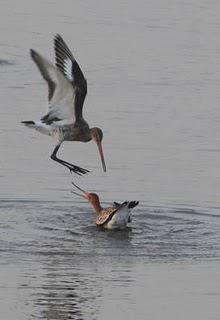
Black-tailed godwits fencing, taken at WWT Welney (c) John Reeves
A pair of black-tailed godwits has successfully reared a brood of three chicks on 80 ha of recently created wetlands at WWT Welney Wetland Centre in Norfolk next to the Ouse Washes reserve.
Black tailed godwits are now a very rare bird on the Ouse Washes with only small numbers breeding compared with over 60 in the 1960s. Like several other wading bird species the losses are due to nests being flooded out more often during springtime. This flooding is due principally to changes in the pattern of rainfallin the catchment of the river Ouse. Eggs and chicks are also being lost to predators like foxes.
There are now a number of projects to provide wetland habitats outside the Ouse Washes to help save breeding wading birds, including the black-tailed godwit. These areas need to have more control over water levels and, where possible, exclude predators during the breeding season by special fencing. The successful breeding at Welney is the first time that black-tailed godwits have successfully raised young chicks outside the Ouse Washes for many years and is a very exciting and important event following careful planning and management of this area by WWT. The success is also important in informing future habitat creation in the area.
This years dry spring has also meant that the Ouse Washes have not experienced flooding and a further three pairs of black-tailed godwit have nested on the WWT Ouse Washes reserve, making this a very successful year for the Welney reserve team.
These charismatic birds are relatively large waders with long legs and an unmistakably long, straight bill. The bill is perfectly adapted for feeding on invertebrates in the muddy habitat of wetland sites like the Ouse Washes. These birds migrate from Africa to the UK in spring when the males take on a beautiful rusty-orange hue to the plumage on their head and neck ready for the breeding season and display over their territories with a distinctive whickering call.
Leigh Marshall, WWT Reserve manager said: ‘It’s great to see these birds using the wetlands that we have created. Black-tailed godwits are a site-specific nesting bird, so if their nesting habitat is flooded they will try to find other suitable areas as close as possible to the original site. The fact that they have chosen to nest on this recently created wetlands site when the Ouse washes are flood-free is testament to the hard work that has been undertaken throughout this project’.
What makes this particular breeding pair significant is the fact that the land on which they have held a territory was, until recently, no different to the farmland in the surrounding area. A joint venture by the Wildfowl & Wetlands Trust (WWT) at Welney, its consultancy WWT Consulting and the Environment Agency, which was also supported by Natural England and Norfolk County Council, was set in motion in 2008 to create additional wetland habitat in the local area. An area – now known as Lady Fen - that covers nearly 80 hectares was converted into wet grasslands to benefit wintering and breeding birds as well as other wetland wildlife, but it also provides summer grazing for the cattle of local farmers.
Geoff Brighty, Central Ares Manager for the Environment Agency said “The Lady Fen site is part of our on-going commitment to ensure that the Ouse Washes can fulfill it's vital role in managing flood risk in the wider Fens as well as being a site of international importance for wildlife. We are delighted that working with WWT the new habitat is proving to be of value to wildlife so soon and the presence of black-tailed godwit is a fantastic endorsement of this”.
Careful management of the land around the visitor centre allow wintering wildfowl areas to safely roost and feed, whilst providing the ideal habitat in the spring for ground nesting waders and passerines. This area has also been beneficial for breeding lapwing, redshank, avocet, little ringed plover and yellow wagtail. During the spring and summer visitors can enjoy watching the displaying birds from the wigeon café and veranda.
Each spring the reserve team at WWT Welney monitor the populations of breeding birds with surveys undertaken from April – June, where the wardens walk transects across the washes. The data that we collect contributes to over 40 years of recording birds at Welney which is then fed into national reports, to complete a wider picture. © Phil Pickin

